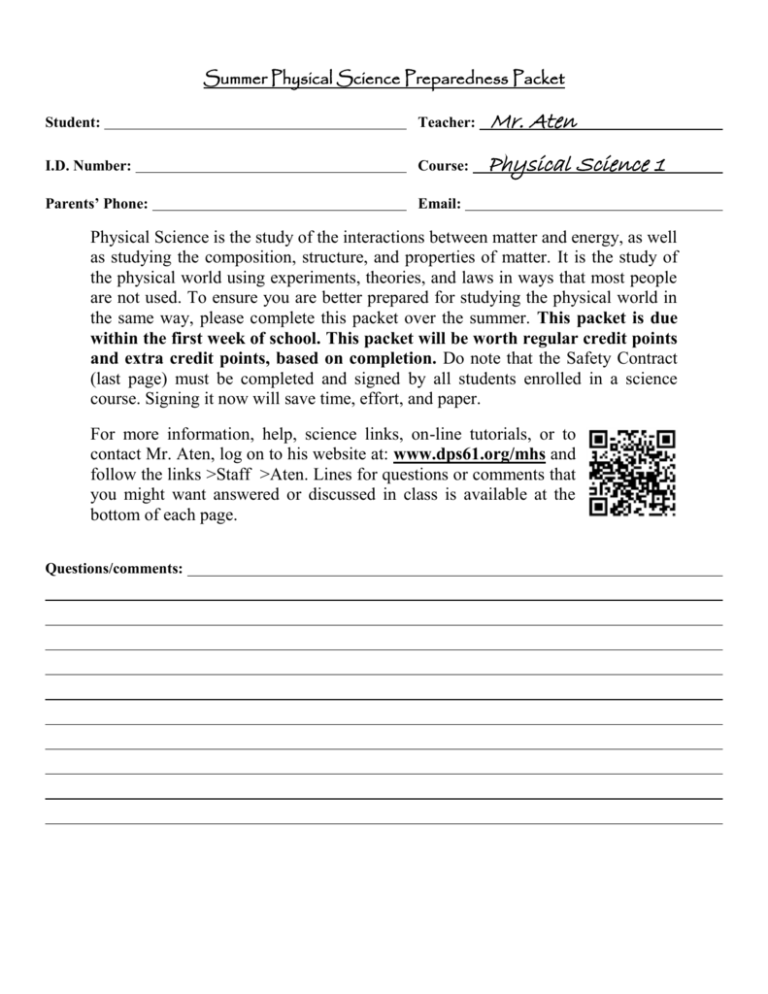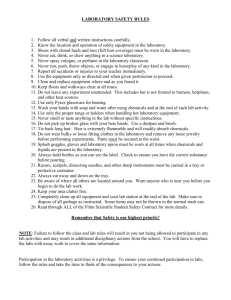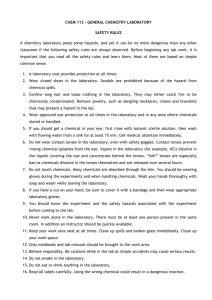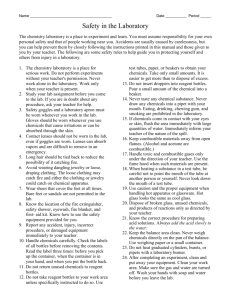Individual Science Readiness Plan
advertisement

Summer Physical Science Preparedness Packet Student: Teacher: Mr. Aten I.D. Number: Course: Physical Science 1 Parents’ Phone: Email: Physical Science is the study of the interactions between matter and energy, as well as studying the composition, structure, and properties of matter. It is the study of the physical world using experiments, theories, and laws in ways that most people are not used. To ensure you are better prepared for studying the physical world in the same way, please complete this packet over the summer. This packet is due within the first week of school. This packet will be worth regular credit points and extra credit points, based on completion. Do note that the Safety Contract (last page) must be completed and signed by all students enrolled in a science course. Signing it now will save time, effort, and paper. For more information, help, science links, on-line tutorials, or to contact Mr. Aten, log on to his website at: www.dps61.org/mhs and follow the links >Staff >Aten. Lines for questions or comments that you might want answered or discussed in class is available at the bottom of each page. Questions/comments: PHYSICAL SCIENCE NAME Summer Preparedness Packet DATE PERIOD Laboratory Safety Read the safety rules (page 8) and answer the following questions. Use complete sentences. 1. In your own words, and based on what you read, what three reasons can you find that make it important to follow these safety rules at all times? 5. List four activities that are ways by which chemicals can accidentally be ingested 6. What are the four ways that chemicals can accidentally enter the body? 2. List four examples of physical injury and describe one simple way to avoid this type of injury. 7. What does it mean to never perform unauthorized experiments and never engage in horseplay in the laboratory? 3. What is so important about the type of clothing worn in a laboratory classroom? 8. Why is it necessary to always demonstrate safe behavior in the laboratory, even when not performing an experiment? 4. What two things do shoes protect you from? Questions/comments: Page 1 PHYSICAL SCIENCE NAME Summer Preparedness Packet DATE PERIOD SI UNITS and SCIENTIFIC NOTATION 1. Match the measurement on the left to the quantity being measured on the right. Quantities are used more than once. a. 2.37 m b. 4.14 kg Length c. 32.6 km Mass d. 9.02 s Temperature e. 6.54 oF Time f. 85.3 mL Volume g. 15.2 mg h. 11.8 oC i. 2.22 L j. 0.77 cm3 k. 6.28 cm l. 7.56 ms 2. Express each measurement in terms of base units (e.g. 44 kg 44000 g). a. 2.37 mm Conversion Units: b. 4.14 cm 1 m = 1000 mm c. 32.6 km 1 m = 100 cm d. 9.02 mL 1 m = 0.001 km e. 6.54 cm3 1 L = 1000 mm f. 85.3 kg 1 L = 1000 cm3 g. 15.2 mg 1 g = 1000 mg h. 11.8 cg 1 g = 1000 cg i. 2.22 kL 1 g = .001 kg j. 0.77 day 1 min = 60 sec k. 6.28 min 1 hr = 60 min l. 7.56 hr 1 day = 24 hr Questions/comments: Page 2 PHYSICAL SCIENCE NAME Summer Preparedness Packet DATE PERIOD USING SIGNIFICANT DIGITS 1. State how many significant digits are represented in each measurement. a. 2.387 m i. 390.0 L b. 114.14 g j. 0.80 mm c. 43.66 K k. 0.080 cm d. 902 s l. 0.0800 m e. 60.3 W m. 1.48x103 K f. 100.8 T n. 6.505x107 J g. 75.00 g o. 8.00x10-5 N h. 1200 J p. 2.110x10-6 A 2. Solve the following experimental calculations. a. 6.3 m + 7.22 m + 3.75 m = c. 443.7 mL – 441 mL = b. 15.8 s + 14.982 s + 6.232 s = c. 1287 m/s – 590 m/s = c. 8.03x103 kg + 7.3x103 kg = d. 1.072x104 km – 7.5x103 km = 3. Solve the following experimental calculations. a. 4410 m x 3122 m = d. 36.5 L x 7.22 m x 3.75 m = b. 57 m x 7.013 m x 3.882 m = e. 17.3 g / 44.75 cm3 = c. (6.3 kg x 9.80 m) / 51.62 s = f. 122.3 N / (9.01 m x 14 m) = 4. Solve the following experimental calculations. a. (328 kg + 822 kg) x 14 m = (157 s – 127 s) b. 328 kg·m + (822 kg x 14 m ) = (157 s – 127 s) c. 328 kg·m + 822 kg x 14 m = 157 s 127 s d. 328 kg·m + 822 kg x 14 m = 157 s + 127 s Questions/comments: Page 3 PHYSICAL SCIENCE NAME Summer Preparedness Packet DATE PERIOD Math Practice Physics is not mathematics (Rule 6), but there is a tremendous amount of mathematics used in physics. The following problems review some math skills you will need for this course. These also are math skills you should already have acquired. 1. Solve for x. a. 128 = 18 + x x= b. 787 = 52 + x x= c. 324 = x + 44 (3) x= d. 1188 = x + 113 (15) x= e. 392 = ½(42 + 56) x x= f. 1680 = (77 + 35) x x= g. 561 = x + 362 x= h. 168 = 17 + x x= i. 1112 = 13(8) + ½ x x= j. 488 = (14 – 8)x x= k. 27 = x + (24) 27 x= l. 122 = 49 + (18) x x= x= b. x = 3370 + 32y – 15z x= 2. Solve for x. a. x = 20 + 5y + 2z y=3 y=7 z=6 z = 13 c. x = (3y + 7y) 5 x= d. x = 9y -1234 y = 3z y = 15 z z = 6(7) + 12 z = 13 + (5) 3. Solve for x. a. 2464 = 32 x b. 26 x = 65 x= x= c. 35 = 1155 x d. 12 = 2208 x x= x= d. 57 = 3x 32 e. 118 = 2x . 24 x= x= Page 4 x= PHYSICAL SCIENCE NAME Summer Preparedness Packet DATE PERIOD RULES OF PHYSICS Learn ‘em Love ‘em Live ‘em 1. Physics exists to teach us critical thinking – nothing else is important. 1b. If you’re not thinking critically, you’re just not thinking. 2. Visualization is more important than units. Draw the picture, stupid. 3. Units, units, units. 4. Release the ego. Nothing ruins physics classes faster than physics classes. 5. Don’t get too excited that your answer is correct. The next problem is just around the corner, and the chances are that it will be a killer. 6. Physics is not Mathematics – don’t treat it that way. Insanity lies down that road. 7. All physics problems are the same problem. The difficulty is realizing what that problem happens to be. 8. There is a fine-line between hardcore and stupidity – try not to cross that line. 9. The universe is stranger, and simpler, than you can ever imagine. Get used to it. 9b. The only way to truly understand the universe is to be born as an 11th dimensional being. In all likelihood, you weren’t that lucky. 10. If it’s stupid, but it works, then it is not stupid. 11. If you understand the following quotes… “Mathematicians know everything about nothing. Engineers know nothing about everything. Physicists know something about something.” – Albert Einstein “Everyone else sux.” – Richard Feynman …then you don’t need the previous 10 rules. Honest. Page 5 PHYSICAL SCIENCE NAME Summer Preparedness Packet DATE PERIOD RULES OF PHYSICS (cont’d) 12. The laws of thermodynamics and conservation of energies regulate all natural processes. 13. All theories must be consistent with all known physical laws, theories, and observations. 14. All theories, hypotheses and observations must be verifiable and falsifiable. 15. Always establish the cause and effect relationship. 16. Complexity ought not be posited without necessity. 17. Words mean things. Read the instructions. 18. Never fall asleep while handwriting a report. (Don’t cram) 19. Never take anything for granted. (Don’t cram) 20. Always anticipate. (Don’t cram) 21. Always wear appropriate protective clothing in the classroom or laboratory, if needed (i.e., e.g. protective eyewear, protective footwear, radiation suit). 21a. Always wear footwear in the classroom or laboratory. 22. Know how to use the safety equipment – eyewash fountains, safety showers, fire blankets, fire extinguishers, emergency spill kits. 23. Never engage in horseplay, games, or pranks in the laboratory. 24. The instigator is almost never caught; the respondent almost always is. 25. The back of the room is never far enough. 26. Dispose of all waste materials using disposal procedures 26a or 26b. 26a. Throw it away (solids). 26b. Dump it in the drain (liquids). 27. Never perform unauthorized experiments. Demonstrate safe behavior. 28. Never run with sharp objects. Page 6 PHYSICAL SCIENCE NAME 107 Summer Preparedness PacketROOM DATE PERIOD SAFETY RULES These Safety Rules are minimum requirements for all science labs. In certain laboratory situations, more specific rules may need to be applied. Working in a science laboratory is normally very safe. To ensure your personal safety and the safety of others, you need to reduce the risks associated with laboratory work. Risk in the science lab can come from either physical or chemical hazards. By examining these hazards, you will understand why the following rules have been developed for working in scientific laboratories. Chemical hazards result from exposure to hazardous chemicals from absorption through skin or eye contact, inhalation, ingestion, or injection. Physical hazards include falls, eye injury, electrical shock and fire. 1. 2. 3. 4. 5. 6. 7. 8. 9. 10. 11. 12. 13. 14. 15. 16. 17. 18. 19. Protect your eyes. They are the most important part of your body. If you get a chemical in your eye, flush with water immediately and tell the teacher. Appropriate eye protection must be worn at all times in the laboratory. Chemical splash goggles provide maximum protection from splashes. Contact lenses should not normally be worn unless approved by the teacher. Unventilated goggles are essential if contact lenses are worn. Wear appropriate protective clothing. Chemicals can burn or irritate the skin. Some chemicals are readily absorbed through the skin and enter the body. Your clothing should cover your legs to the knees. Shorts are not appropriate for the laboratory. When applicable, laboratory coats or aprons can protect good clothing. Loose clothing should not be worn because it may dip into chemicals or fall into a flame and catch fire. Wear shoes that cover your feet. Sandals and open-toed shoes do not protect your feet from broken glass that is frequently found in science laboratories. Also, leather shoes protect your feet from chemical spills; canvas shoes do not. Do not apply cosmetics, comb hair, eat, or drink in the laboratory. These activities are ways by which you can accidentally ingest harmful chemicals. Do not taste any chemical. Do not smell chemicals directly. Smell a chemical; only if your teacher specifically tells you to do so, then use your hand to fan the vapor to your nose. Do not pipette solutions by mouth. Use a rubber suction bulb or other device to fill a pipette so that you do not draw chemicals into the mouth. Wash your hands with soap and water before leaving the laboratory. This rule applies even if you have been wearing gloves. Know the hazards of the materials being used. Read labels carefully to make sure you are using the right chemical. Know how to interpret data from a Material Safety Data Sheet, MSDS. Remember that hot and cold glassware look the same, so allow ample time for cooling. If you are not sure if the glassware is extremely cold or hot, use precaution when handling that glassware. Tie back loose hair. Dangling hair can fall into a Bunsen burner and catch on fire or can fall into a chemical solution. Know the safety equipment. Know the location of eyewash fountains, safety showers, fire blankets, fire extinguishers, and emergency exits. Know how to respond in case of an emergency. Know how to use the safety equipment. Carry out only the experiments assigned by your teacher. Never perform unauthorized experiments. Never remove chemicals from the laboratory. Never work in the laboratory unless authorized to do so by your teacher. Never work alone in the laboratory. In case of a problem, you may need another person to prevent injury or even save a life. Never engage in horseplay, games, or pranks in the laboratory. Remember that the laboratory is a place for serious work. Careless behavior can endanger yourself and others and will not be tolerated. Demonstrate safe behavior. Obey all safety instructions given by your instructor or found in your experimental procedure. Clean up spills immediately if you know how. If you are uncertain how to clean up a spill or if a large spill occurs, notify your instructor immediately. Before leaving the laboratory, return equipment and chemicals to their proper places. Clean up your work area. Dispose of all waste materials according to your teacher’s instructions. Report any accidents or unsafe conditions to your teacher immediately. The procedures for heating chemicals are: (1) angle the test tube, (2) keep the test tube moving, and (3) point the opening of the test tube away from others and yourself. Page 7 PHYSICAL SCIENCE NAME Summer Preparedness Packet DATE PERIOD SAFETY CONTRACT Students will be removed from the laboratory by the teacher if: their personal appearance or dress is such that they can cause injury or distraction to themselves or others; they are behaving in such a manner that they can cause injury to themselves or others; they are not following the prescribed safety rules for the laboratory or the particular activity being conducted; they have not completed the pre-lab activities that are needed for them to work safely in the laboratory. I, , a student at School, have read and agree to follow all safety rules and regulations given by my teacher. I realize that following these rules is necessary to ensure the safe operation of the school laboratory and to provide a safe environment not only for myself, but for my fellow students and my teachers as well. I will, therefore, cooperate fully with teachers and students to ensure that all of us work safely. I will act responsibly to look for possible safety hazards and will immediately point out these hazards to the instructor. I realize that, as a student, much of the responsibility for safety is in my hands. I understand that violation of these rules may result in the loss of laboratory privileges and possible disciplinary measures. Contact Lens Wearers Wearing contact lenses in the laboratory is the subject of controversy because of the extra risk they create in case chemicals enter the eye. Some experts believe that contact lenses should never be worn in the laboratory. Other experts believe that contact lenses can be worn with proper eye protection. I will wear contact lenses in the laboratory. Yes____ No____. If yes, I realize the hazards associated with the use of contact lenses and will strictly adhere to the eye protection requirement. Signed: Date: / / (student) I, , parent or guardian of contract and the attached rules. Signed: , have read this safety Date: / / (parent / guardian) (parent’s email) For more information, assignments, science links, on-line tutorials, and Star Tripp’n’ episodes, contact Mr. Aten by phone, by e-mail, or by logging on to his website at: www.dps61.org/mhs and following the links >Staff >Aten. katen@dps61.org 424-3156 Page 8




